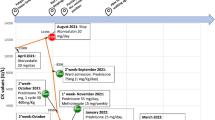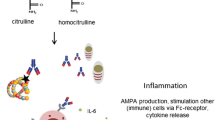Abstract
The aim of the study was to elucidate the involvement of Fas antigen in human autoimmune disease, by analysing serum levels of soluble Fas/APO-1 protein in patients with various autoimmune diseases, including system lupus erythematosus (SLE), rheumatoid arthritis (RA), systemic sclerosis (SSc), polymyositis/dermatomyositis (PM/DM), Behçet's syndrome and Sjögren's syndrome (SjS). The levels of soluble Fas/APO-1 in sera were quantitated by a sandwich enzymelinked immunosorbent assay. Soluble Fas/APO-1 levels were significantly increased in serum from patients with primary Sjögren's syndrome (1° SjS) compared with control subjects. However, no significant differences in soluble Fas/APO-1 levels were noted in patients with secondary Sjögren's syndrome (2° SjS) nor in patients with any of the other autoimmune diseases. The soluble Fas/APO-1 level in 1° SjS patients with extraglandular diseases was significantly higher than that in patients without extraglandular diseases. These results suggest that soluble Fas/APO-1 protein may play an important role in the pathogenesis of 1° SS.
Similar content being viewed by others
References
Wtanabe-Fukunaga R, Brannan CI, Copeland NG, Jenkins NA, Nagata S. Lymphoproliferation disorder in mice explained by defects in Fas antigen that mediates apoptosis. Nature 1992; 356:314–7.
Takahashi T, Tanaka M, Brannan CI, et al. Generalized lymphoproliferative disease in mice caused by a point mutation in the Fas ligand. Cell 1994;76:969–76.
Nagata S, Goldstein P. The Fas death factor. Science 1995;267:1449–56.
Lynch DH, Watson ML, Alderson MR, et al. The mouse Fasligand gene is mutated in gld mice and is part of a TNF family gene cluster. Immunity 1994;1:131–6.
Ramsdell F, Seaman MS, Miller RE, Tough TW, Alderson MR, Lynch DH. Gld/gld mice are unable to express a functional ligand for Fas. Eur J Immunol 1994;24:928–33.
Sneller MC, Wang J, Dale JK, et al. Clinical, immunologic, and genetic features of an autoimmune lymphoproliferative syndrome associated with abnormal lymphocyte apoptosis. Blood 1997; 89:1341–8.
Mysler E, Bini P, Drappa J, et al. The apoptosis-1/Fas Protein in human systemic lupus erythematosus. J Clin Invest 1994;93:1029–34.
Skarstein K, Jonssor R. The apoptosis related APO-1/Fas (CD95) receptor is expressed in MRL/lpr mice despite defect in the Fas gene. Clin Rheumatol 1995;69:27.
Matsumura R, Kagami M, Tomioka H, et al. Expression of ductal Fas antigen in sialoadenitis of Sjögren's sydnrome. Clin Exp Rheumatol 1996;14:309–11.
Cheng J, Zhou T, Liu C, et al. Protection from Fas-mediated apoptosis by a soluble form of the Fas molecule. Science 1994;263:1759–62.
Knipping E, Krammer PH, Onel KB, Lehman TJA, Mysler E, Elkon KB. Levels of soluble Fas/Apo-1/CD95 in systemic lupus erythematosus and juvenile rheumatoid arthritis. Arthritis Rheum 1995;38:1735–7.
Goel N, Ulrich DT, Clear EWST, Fleming JA, Lynch DH, Seldin MF. Lack of correlation between serum soluble Fas/APO-1 levels and autoimmune disease. Arthritis Rheum 1995;38:1738–43.
Bombardier C, Gladman DD, Urowitz MB, Caron D, Chang CH. Derivation of the SLEDAI. A disease activity index for lupus patients. The Committee on Prognosis Studies in SLE. Arthritis Rheum 1992;35:630–40.
Takeuchi T, Pang M, Amano K, Koide J, Abe T. Reduced protein tyrosine phosphatase (PTPase) activity of CD45 on peripheral blood lymphocytes in patients with systemic lupus erythematosus. Clin Exp Immunol 1997;109:20–6.
Vital C, Bombardieri S, Moutsopoulos HM, et al. Preliminary criteria for the classification of Sjögren's syndrome: results of a prospective concerned action supported by European Community. Arthritis Rheum 1993;36:340–7.
Tan EM, Cohen AS, Fries JF, Masi AT, MaShane DJ, et al. The 1982 revised criteria for the classification of systemic lupus erythematosus. Arthritis Rheum 1982;25:1271–7.
Arnett FC, Edworthy SM, Bloch DA, et al. The American Rheumatism Association 1987 revised criteria of the classification of rheumatoid arthritis. Arthritis Rheum 1988;31:315–23.
Subcommittee for Scleroderma Criteria of the American Rheumatism Association Diagnostic and Therapeutic Criteria Committee. Preliminary criteria for the classification of systemic sclerosis (scleroderma). Arthritis Rheum 1980;23:581–90.
Bohan A, Peter JB, Bowman RL, Pearson CM. A computer-associated analysis of 153 patients with polymyositis and dermatomyositis. Medicine (Baltimore) 1977;56:255–86.
Moutsopoulos HM. Sjögren's syndrome. In: Schumacher HRJ, editor. Primer on the rheumatic disease. Atlanta: Arthritis Foundation, 1993;131–5.
Jodo S, Kobayashi S, Kayagaki N, et al. Serum level of soluble Fas/APO-1(CD95) and its molecular structure in patients with systemic lupus erythematosus (SLE) and other autoimmune diseases. Clin Exp Immunol 1997;89–95.
Tsuzaka K, Fujii T, Akizuki M, et al. Clinical significance of antibodies to native or denatured 60-kd or 52-kd Ro/SS-A proteins in Sjögren's syndrome. Arthritis Rheum 1994;37:88–92.
Adachi M, Watanabe-Fukunaga R, Nagata S. Aberrant transcription caused by the insertion of an early transposable element in an intron of the Fas antigen gene of 1pr mice. Proc Natl Acad Sci USA 1993;90:1756–60.
Dang H, Ogawa N, Nakabayashi T, Anaya JM, Liu GT, Talal N. Elevated Fas expression and blocked apoptosis in infiltrating lymphocytes from salivary glands from patients with primary Sjögren's syndrome. Arthritis Rheum 1995;38(suppl):S378.
Vita SD. Ductal Fas antigen and pathobiology of Sjögren's syndrome. Clin Exp Rheumatol 1996;14:231–4.
Author information
Authors and Affiliations
Corresponding author
Rights and permissions
About this article
Cite this article
Fujihara, T., Takeuchi, T., Tsubota, K. et al. Serum soluble Fas/APO-1 is increased in patients with primary Sjögren's syndrome. Clin Rheumatol 17, 496–499 (1998). https://doi.org/10.1007/BF01451286
Received:
Accepted:
Issue Date:
DOI: https://doi.org/10.1007/BF01451286




